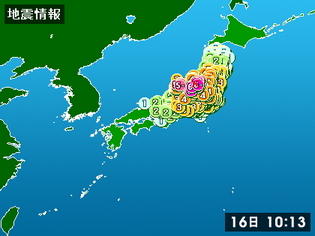The Central Disaster Prevention Council released a report yesterday detailing the results of a computer simulation of the aftermath of a high-magnitude quake in the Tokyo area. The report was based on a survey of 200 company employees and house wives, who were asked, "If an earthquake occurred, would you immediately try to walk home from your current location?" Using the results of the survey, the council estimated that, if an earthquake occurred during the afternoon on a weekday, of the almost 14 million people not at home, about 12.5 million would attempt to walk home. These numbers are quite startling to begin with, and the report goes on to quote headline-making statistics such as "From Tokyo station to Shinjuku, 3.6 hours; 14 hours to Yokohama" (Yomiuri) and "Over 200,000 would have to walk more than 3 hours" (Mainichi).
 Seismic activity on Honshu If these statistics weren't enough to brew anxiety in the metropolitan population, the report goes on to discuss the conditions under which these millions would have to walk home, stating that the streets would resemble a maximum-capacity train; many would be crushed, with about 6 people per square meter. Is it even possible to walk anywhere, much less home, under these conditions?
Seismic activity on Honshu If these statistics weren't enough to brew anxiety in the metropolitan population, the report goes on to discuss the conditions under which these millions would have to walk home, stating that the streets would resemble a maximum-capacity train; many would be crushed, with about 6 people per square meter. Is it even possible to walk anywhere, much less home, under these conditions?
Unfortunately, having grown to be a sprawling and mammoth metropolitan area, Tokyo has over a long period of time inadvertently put itself into this dangerous situation. It does seem, however, that if such a large earthquake did occur, there would be much more to worry about than millions of people all trying to get home at once. With such a high density of people crammed into a small area, in the event of a catastrophe we have to wonder how many of these people would even be capable of walking home. This is a gruesome but far more realistic question to ask. And while no one wants to think about such a fatal disaster occurring, mentally we may be more prepared to consider these aspects when preparing for a disaster. There is no need to scare the general population further with even more sensationalist statistics—i is just one more thing for people to worry about.
It is important to cover all bases, however, and the government is now taking steps to organize and disperse those who would be at risk into manageable groups. While there is a bit of fear mongering at work, with such a large and condensed city in such an active fault zone, the risk is a reality. It would be best to learn from other incidents of quakes occurring in major cities, but unfortunately there is no real applicable examples. Let's hope Tokyo won't be the first.
Blog:
Tags:
Other posts by Sarah:






